New Year ushers in an early Spring
Friday, January 27, 2012
It's far to early to think that winter is behind us because
there could still be a nasty sting in the tail, but I can't
remember a January with so much colour in the garden. Snowdrops,
cyclamen coum, primroses, daffodils (just a few) and especially our
beloved hellebores. It has been good gardening weather too with
plenty of time to devote to the battle with bittercress our most
pernicious weed that doesn't stop growing and if you let it flower
and set seed look out.....! Its best to do this by hand or with a
small fork although the only saving grace is that bittercress pulls
out easily
Wild Snowdrops in woodland not far from Cilgwyn
Lodge
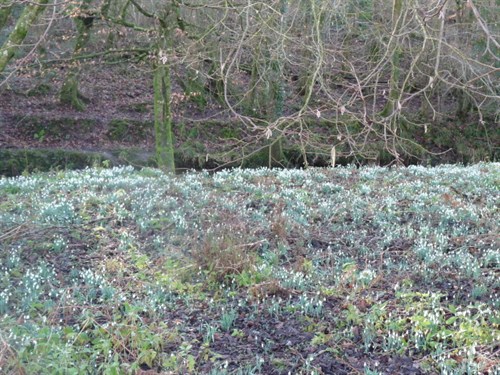
There are a few other weeds too but not on the scale of the
dreaded one. I still haven't cut back the herbaceous borders even
though it has been tempting to do so. You read all sorts of
conflicting opinions about the best time to do this and it all
comes down to personal preference and past experience. I take the
view that there is a lot of merit in the dead haulms protecting the
roots especially of more vulnerable perennials and given that every
year we have succeeeded in getting dahlias, some salvias and
diaramas through even the most severe winters. It may look untidy,
(in frosty weather the frost patterns are lovely) but it works for
me.
Weather report
A changeable month with lots of rain, wind in early month, a few
cold spells including 2 nights mid month of -5C (making it just 6
air frosts this winter), some sunshine and a max of 13C. No wonder
the plants are growing fast. The nights are getting lighter
too which is a great feeling and my sap is rising as quickly as the
plants!
Garden Update
Because of all the work I have done in the borders the garden
looks as tidy as I can remember it in January. The vegetable garden
has been cleared save for late cropping brassicas, leeks and
parsnips, ready for rotovating in March (weather permitting). The
grass is green and growing away in the lawns and all of the
surrounding fields - last year they were all yellow.
Some shrubs are showing swelling leaf buds, and the flower buds
on magnolia stellata and some of the viburnums, all of which flower
before the leaves, are also forming. A large cornus mas with yellow
slightly scented flowers resembling mimosa is a pretty sight, a
full month ahead of its normal bloom time here.
Emerging flowers of cornus mas
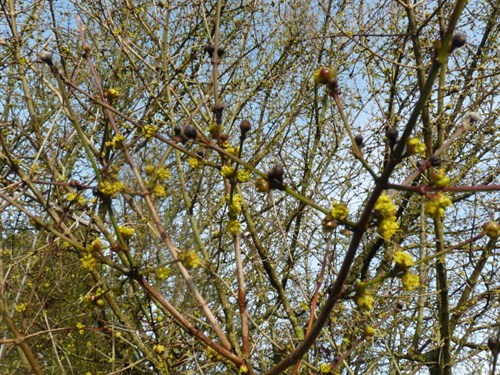
In the polytunnels and greenhouses (so much cheaper to heat than
last year - a blessing with large propane at £65 a bottle) there is
plenty of colour and we still have a few red peppers to harvest!
There are hellebores in flower in pots, some good double primroses
from the bellarina range and a real mimosa, acacia baileyana
"Purpurea",
The real thing acacia in full bloom. New leaf growth is
deep purple if exposed to direct sunlight and is an impressive
feature of this cultivar
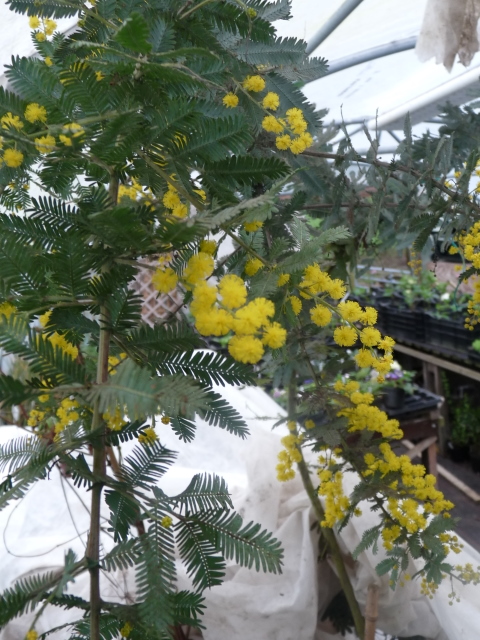
There are also a few flowers on cestrum newellii, brugmansia
sanguinea, alogyne hueglii, and euryops pectinatus a lovely bright
yellow shrubby daisy with grey foliage, all of them raising
the spirits on dull days and all for the price of keeping them just
frost free and plenty of horticultural fleece on colder nights. The
polytunnels can generally stay frost free without heat when the
temperature doesn't fall below -2C
Another treaure in the polytunnel is this tender
mallow, malva bicolour which flowers year round in a little
heat
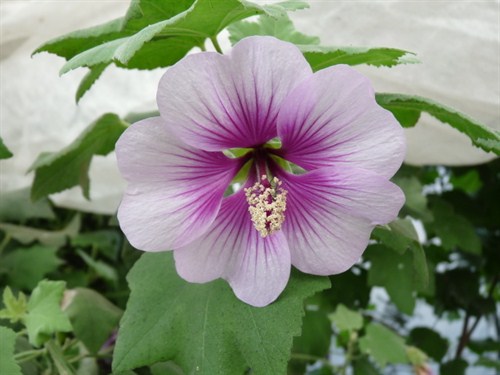
The many overwintering herbaceous plants in the frames and
tunnels are beginning to move and as soon as they show real growth
it will be time for us to start the major potting on task which on
and off alongside other tasks, takes up to 2 months. They have done
very well this winter and hopefully there should be far fewer
losses than last year.
Seed sowing has started in earnest and all the seeds from the
societies we belong to ordered and our own gathered seed sorted and
cleaned. I love seed sowing above all else - giving life to new
plants and delighting in all the outcomes. You never know quite
what you are going to get as seeds of many cultivars and to a
lesser extent, species, don't always come true to type. About 250
packets of seed to sow. Yes I know I say it every year, I must be
crazy but what fun especially when some seeds notably clematis can
take up to 3 years to germinate and another couple of years to
flower. Its a bit like Christmas: in a perverse way I sometiimes
think the waiting and anticipation are almost the best
part!!
What's looking good?
Obviously the "Spring Garden" along the beech hedge walk and the
"woodland" garden, both full of hellebores - over 200 of them all
over the garden but mostly concentrated in these 2 areas. A great
range of colours, shapes and forms from over 20 years of collecting
them - and still we are adding to them but it gets more difficult
as we have become fussy!. They now have to be very special before
we add them to our collection, either species forms we don't
already have or really choice x hybridus forms. There is also a
good range of emerging x sternii (argutilious x lividus) and
ericsmithii (sternii x niger ), forms raised from difficult crosses
in which the leaf patterns and colours are a special feature.
Helleborus x ericsmithii "Winter Moonbeam" showing
lovely leaf patination arising from the 3 way cross and "hybrid
vigour". It as already a substantial plant after just 2 years. We
have one of the early crosses still going strong after 15
years!
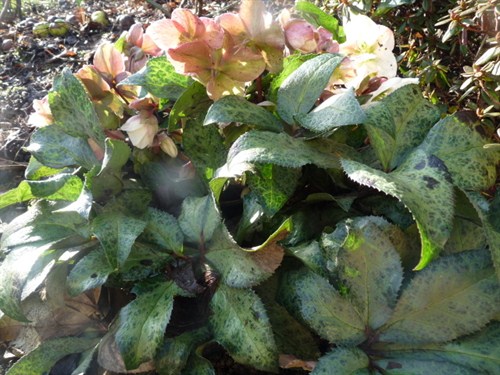
The range of Harvington Hybrids now widely available are some of
the best and at Batsford Arboretum Nursery last week we found a
tremendous red double, the nearest to true red I have ever
encountered. I have planted it so that the late evening sun can
shine through it and intensify the colour. The consistency and
quality of the Harvington range is very impressive and should be
sought out by collectors, Another advantage is that they are very
competitively priced for such quality plants.
The marvellous double red Harvington hybrid hellebore -
don't forget to add the sunshine to the mix to get the best
colour!
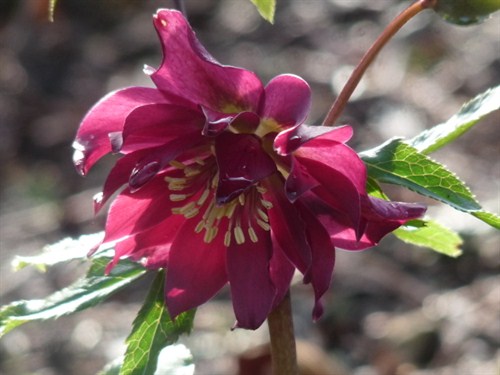
Other planting companions (snowdrops, cyclamen coum (lots of
seedlings this year), primroses, grape hyacinths and pulmonarias
already in flower) complement the hellebores very well, augmented
by recent additions of sarcocca confusa and hookeriana. This low
growing beutifully scented small shrub is usually pretty tough but
only 3 survived in the entire gardens after last winters cold.
A lovely grouping of cyclamen coum showing the colour
variation
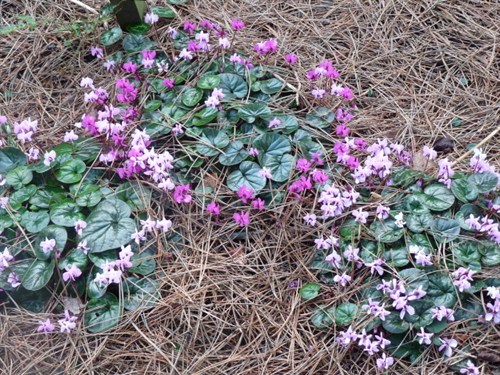
A special mention must be made of the Brussels sprouts
(varieties "Trafalgar" and "Bosworth") which are in terrific shape
and tasting lovely with plenty more to come - and for the excellent
leeks which have avoided the onion white rot which affected most of
the other onion tribe last summer. Vegetables in store are keeping
well giving us a a good choice each day. Onions in store
however are not faring so well because of the problems last summer
and we may even have to buy some befroe the winter is out -
something I don't like to admit to!! We also have a range of salad
leaves in the polytunnels.
Wildlife and nature
Considering the mild January very few frogs have been seen, just
a few in the Paddock Pond sitting amongst the lily pads, newts too
swimming in the clear water which has not frozen over once this
winter. The fish are active and showing after dark in the light of
the LCD lights.
Just after Christmas when there were some severe gales we saw a
few cormorants flying over, driven inland by the weather out to sea
- we are 35 miles from the nearest coast, Fortunately they did not
stop for a fishing trip!
Mice have been active in the tunnels taking great pleasure in
nipping of all the emerging hellebore flowerbuds and digging up a
few bulbs. Protective measures have been taken.
In the hedgerows and elsewhere there are wildflowers way ahead
of their normal bloom times. Celandines, daisies, buttercups and in
the bog garden at Batsford Arboretum, some kingcups.
Visits
The winter talks season re - commences in February with 5 talks
booked and we are looking forward to them with some new venues
including the Monmouthshire Group of The Hardy Plant Society. Most
requested talk this year is "Designing (Gardening) with Perennials
- Colour Schemes fo the Flower Garden" The annual Llandysul Winter
Gardening Weekend takes place from 24 - 26 February and I am doing
2 sessions on the 25th with a Gardeners Question Time and a talk on
Growing Vegetables. For further information go to
www.llandysul-ponttyweli.co.uk
We went up to the Cotswolds mid month to stay with our friends
Sylvia and Tony. Whilst we were there we visited Batsford Arboretum
and Sezincote near Moreton-in-Marsh. Batsford is a lovely relaxed
woodland garden with some good winter interest including a good
range of hamamaelis and daphne bholua species and cultivars. Great
restaurant and nursery/garden centre.
In respect of the daphne it was interesting to compare the
merits of this group. "Jacqueline Postil" is generally considered
to be the best of the cultivars but "Sir Peter Smithers" seems to
me to be a stronger growing and better scented form. particularly
as the two appeared to have been planted in the gardens at the same
time. The species form was equally impressive even though the
flowers are smaller but there were more of them so the scent was
more pervasive. There are two other excellent cultivars with more
reddish/pink flowers namely "Darjeeling" and "Ghurka" not in
evidence at Batsford but both of which can be seen at Abergalsney
Gardens. Not having seen them all together it is difficult to make
comparisons.
Flowers of daphne "Sir Peter Smithers" good colour and
size and that perfume.....!
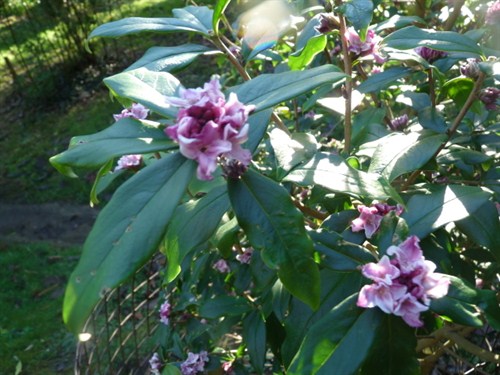
The highlight though of the visit to Batsford amongst many
highlights was not the welcome provided by the flowering plants,
but by the twigs and branches of a magnificient mature acer
sangokaku, the so called coral bark maple, in full, bright winter
sunshine.
The whole tree seems to be on fire!!
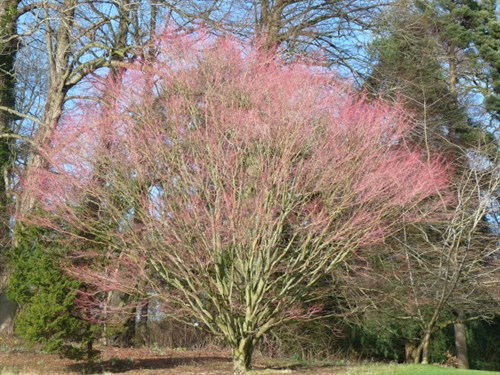
At Sezincote, apart from snowdrops there wasn't much of interest
at this time of year from a plantsman's point of view, but the
house built of local Cotswold stone in a Mogul style from the late
18th Century that pre-dates the Brighton Pavilion, is amazing and
having wanted to see it for many years we were not
disappointed.
The main house and orangery
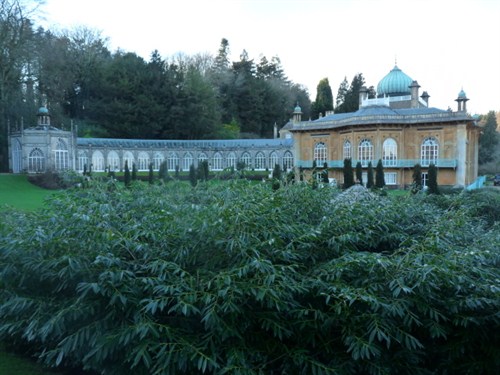
On a more intimate scale there are some lovely touches in the
orangery (the single storey building on the left) like the coloured
glass panels in a Gothic archway. Living as we do in a Gothic house
it was a delight for us.
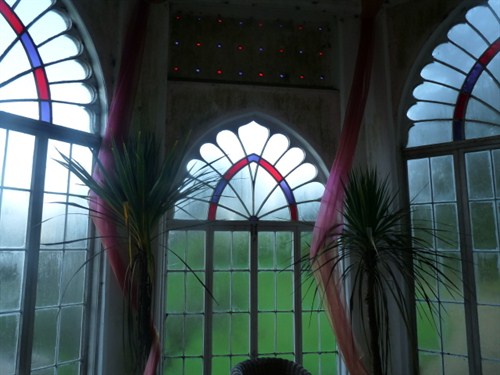
National Botanic Garden of Wales
Nearer to home we have taken advantage of free entry in January
to the National Botanic Garden of Wales. An antiques fair in mid
month was a first for the Garden and saw the best ever weekend
attendance of 6,800 visitors - a record. It was great to see so
many people there and it is to be hoped they will return again when
they have to pay!! as even at this time of year there is plenty to
see. Not difficult to see why it was voted the best winter
gardening attraction in the UK.
The Great Glasshouse and all the crowds
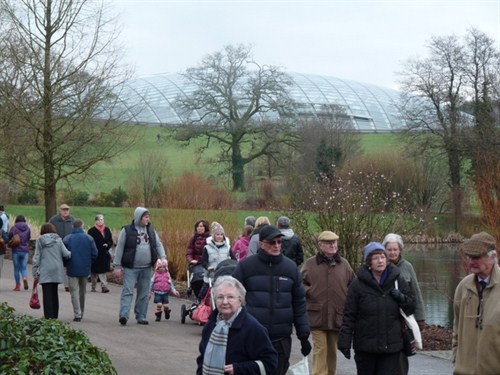
The Antiques Fair in the Great Glasshouse
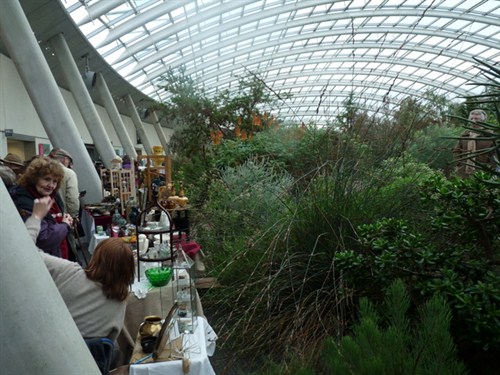
The Great Glasshouse showcasing Mediterranean plants from around
the world is coming into spectacular flower which is heartwarmimg
on a cold winters day. Particular current stars are mostly South
African in origin with proteas, leucodendrons and pelargoniums to
the fore but for me the star performer is a marvellous aloe in full
bloom (I thiought i put the name in my notebook but now I can't
find it - old age!)
The marvellous aloe - a rather upmarket form of
red hot poker !
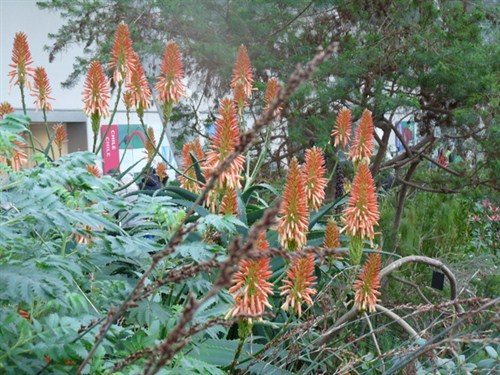
Cilgwyn Lodge openings 2012
Finally just a reminder of visiting arrangements to Cilgwyn
Lodge this summer. We will not be having any garden visitors before
August due to the building of our conservatory and regrettably
there will be no Open Day this year. The nursery will however be
open from June onwards. For garden bookings in late summer
please get in touch as soon as possible. Ther is still plenty to
see in the garden then. To visit the nursery please contact
us via e-mail or by telephone just to make sure we will be home be
home when you intend to visit.
Happy New Year and Happy Gardening!